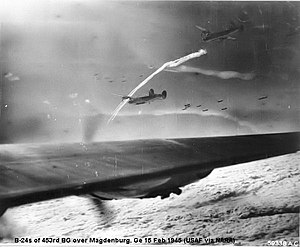
Royal Air Force Old Buckenham or more simply RAF Old Buckenham is a former Royal Air Force station located 2 miles (3.2 km) south east of Attleborough, Norfolk, England which was used during the Second World War by the United States for the strategic bombing campaign against Germany.

The 458th Air Expeditionary Group is a provisional United States Air Force unit assigned to United States Air Forces in Europe to activate or inactivate as needed. The most recent known activation of the unit was at Ramstein Air Base, Germany in 2011.

The 453rd Bombardment Group is an inactive United States Air Force unit that was first organized in June 1943, during World War II, as a Consolidated B-24 Liberator heavy bomber group. After training in the United States, it deployed to England in December 1943, and, starting in February 1944, participated in the strategic bombing campaign against Germany with Eighth Air Force. Its 733d Bombardment Squadron completed 82 consecutive missions without a loss, a record for Eighth Air Force bomber units. James Stewart, of film fame, was group operations officer from 31 March to 1 July 1944. The group was programmed for redeployment to the Pacific and returned to the United States in May 1945 for training, however the Japanese surrender cancelled these plans and the group was inactivated in September 1945.
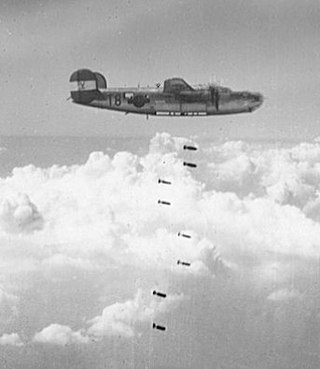
The 491st Bombardment Group is a former United States Army Air Forces unit. It was activated in October 1943 as a heavy bomber unit, drawing its cadre from the former 17th Antisubmarine Squadron. After training in the United States, the group deployed to the European Theater of Operations, where it participated in the strategic bombing campaign against Germany, earning a Distinguished Unit Citation in an attack against Misburg. The group flew 187 combat missions. Following V-E Day, the group returned to the United States and was inactivated at McChord Field, Washington in September 1945.

The 865th Technical Training Squadron is an inactive United States Air Force unit. Its last assignment was with the 1st Missile Division at Redstone Arsenal. Alabama, where it trained Italian Air Force personnel on the SM-78 Jupiter. It was inactivated on 1 November 1959.

The 863rd Bombardment Squadron is a former United States Army Air Forces unit. It was first organized as the 518th Bombardment Squadron in October 1942, when it replaced a National Guard unit participating in antisubmarine patrols off the Atlantic coast, becoming the 13th Antisubmarine Squadron in November. When the Navy took over the coastal antisubmarine mission in August 1943, the squadron moved to the western United States, where it formed the cadre for the 493rd Bombardment Group and was redesignated as the 863rd. It moved to England in the spring of 1944 and participated in the strategic bombing campaign against Germany until April 1945. It returned to the United States and was inactivated in August 1945.

The 856th Bombardment Squadron was a United States Army Air Forces unit. it was first activated in October 1943 as one of the original Consolidated B-24 Liberator squadrons of the 492d Bombardment Group. After deploying to England, the 492d entered the strategic bombing campaign against Germany, but in three months of combat, the 492d Group suffered the most severe losses of an Eighth Air Force bomber group. The 492d Group was withdrawn from combat in August 1944, and the 856th moved on paper to replace the 36th Bombardment Squadron, which was engaged in Operation Carpetbagger, dropping agents and supplies behind German lines, primarily in France. As American forces advanced in France, this special operations mission diminished. The squadron briefly transported fuel to mechanized units in France, then returned to special operations in Scandinavia and Germany under the operational control of Eighth Air Force until the end of hostilities in Europe. It returned to the United States for conversion to Boeing B-29 Superfortresses, but was inactivated in October 1945.

The 752nd Bombardment Squadron is a former United States Army Air Forces unit. The squadron was first activated in July 1943. After training with Consolidated B-24 Liberator heavy bombers in the United States, it deployed to the European Theater of Operations, where it participated in the strategic bombing campaign against Germany. Following V-E Day, the squadron returned to the United States, where it began training with Boeing B-29 Superfortresses, but was inactivated in October 1945.
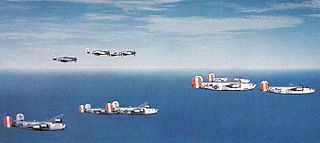
The 753rd Bombardment Squadron is a former United States Army Air Forces unit. The squadron was first activated in July 1943. After training with Consolidated B-24 Liberator heavy bombers in the United States, it deployed to the European Theater of Operations, where it participated in the strategic bombing campaign against Germany. Following V-E Day, the squadron returned to the United States, where it began training with Boeing B-29 Superfortresses, but was inactivated in October 1945.

The 754th Bombardment Squadron is a former United States Army Air Forces unit. The squadron was first activated in July 1943. After training with Consolidated B-24 Liberator heavy bombers in the United States, it deployed to the European Theater of Operations, where it participated in the strategic bombing campaign against Germany. Following V-E Day, the squadron returned to the United States, where it began training with Boeing B-29 Superfortresses, but was inactivated in October 1945.

The 703d Tactical Air Support Squadron is an inactive United States Air Force unit. It was last assigned to the 507th Tactical Air Control Wing at Shaw Air Force Base, South Carolina, where it was inactivated in June 1988.

The 713th Fighter-Bomber Squadron is an inactive United States Air Force unit. It was last assigned to the 448th Fighter-Bomber Group at Davis Field, Oklahoma, where it had been stationed since November 1955. It was inactivated on 16 November 1957.
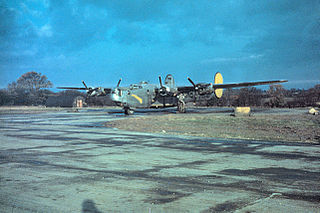
The 844th Bombardment Squadron is an inactive United States Air Force unit. It was assigned to the 489th Bombardment Group, flying Consolidated B-24 Liberators. After training in the United States, it moved to England and engaged in the strategic bombing campaign against Germany until V-E Day. It returned to United States in 1945 and began training with the Boeing B-29 Superfortress, but was inactivated at March Field, California on 17 October 1945.
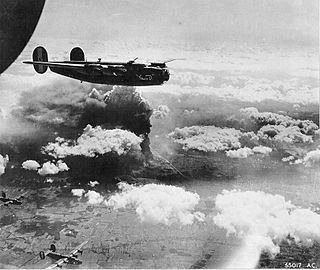
The 845th Bombardment Squadron is an inactive United States Air Force unit. It was last assigned to the 489th Bombardment Group. It was assigned to the 489th Bombardment Group, flying Consolidated B-24 Liberators. After training in the United States, it moved to England and engaged in the strategic bombing campaign against Germany until V-E Day. It returned to United States in 1945 and began training with the Boeing B-29 Superfortress, but was inactivated at March Field, California on 17 October 1945.

The 790th Bombardment Squadron is a former United States Army Air Forces unit, established as a Consolidated B-24 Liberator squadron in 1943. After training in the United States, it moved to the European Theater of Operations the following year. During World War II it was assigned to the 467th Bombardment Group, and engaged in the strategic bombing campaign against Germany. After V-E Day, the squadron returned to the United States and transitioned into the Boeing B-29 Superfortress. It was inactivated on 4 August 1946 at Clovis Army Air Field, New Mexico in March 1946 and its resources were transferred to another unit.

The 791st Bombardment Squadron is a former United States Army Air Forces unit. During World War II it was assigned to the 467th Bombardment Group, and engaged in the strategic bombing campaign against Germany. After V-E Day, the squadron returned to the United States and transitioned into the Boeing B-29 Superfortress. It was inactivated on 31 March 1946 at Roswell Army Air Field, New Mexico in March 1946 and its resources were transferred elsewhere.

The 727th Bombardment Squadron is a former United States Army Air Forces unit. It was last assigned to the 451st Bombardment Group at Dow Field, Maine, where it was inactivated on 26 September 1945. The squadron was activated during World War II as one of the original squadrons of the 451st Bombardment Group. After training in the United States, it served in the Mediterranean Theater of Operations, where it participated in the strategic bombing campaign against Germany. It earned three Distinguished Unit Citations for its combat actions. After VE Day the squadron returned to the United States, where it was inactivated.

The 733d Bombardment Squadron is a former United States Army Air Forces unit. It was assigned to the 453d Bombardment Group and last stationed at Fort Dix Army Air Base, New Jersey, where it was inactivated on 12 September 1945. The squadron was first activated in May 1943. After training in the United States with the Consolidated B-24 Liberator, the squadron deployed to the European Theater of Operations, participating in the strategic bombing campaign against Germany. Following V-E Day, the squadron returned to the United States for conversion as a very heavy bomber unit, but inactivated instead.

The 734th Bombardment Squadron is a former United States Army Air Forces unit. It was assigned to the 453d Bombardment Group and last stationed at Fort Dix Army Air Base, New Jersey, where it was inactivated on 12 September 1945. The squadron was first activated in May 1943. After training in the United States with the Consolidated B-24 Liberator, the squadron deployed to the European Theater of Operations, participating in the strategic bombing campaign against Germany. Following V-E Day, the squadron returned to the United States for conversion as a very heavy bomber unit, but inactivated instead.

The 735th Bombardment Squadron is a former United States Army Air Forces unit. It was assigned to the 453d Bombardment Group and last stationed at Fort Dix Army Air Base, New Jersey, where it was inactivated on 12 September 1945. The squadron was first activated in May 1943. After training in the United States with the Consolidated B-24 Liberator, the squadron deployed to the European Theater of Operations, participating in the strategic bombing campaign against Germany. Following V-E Day, the squadron returned to the United States for conversion as a very heavy bomber unit, but inactivated instead.
